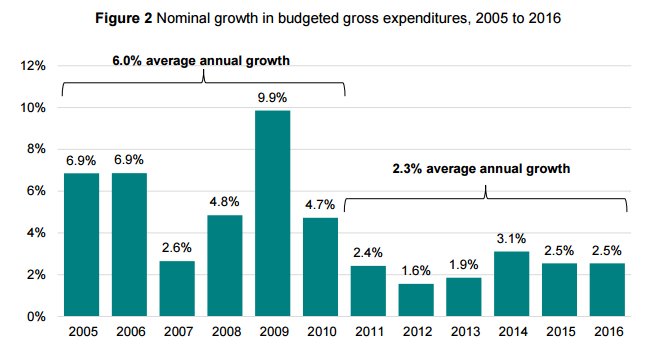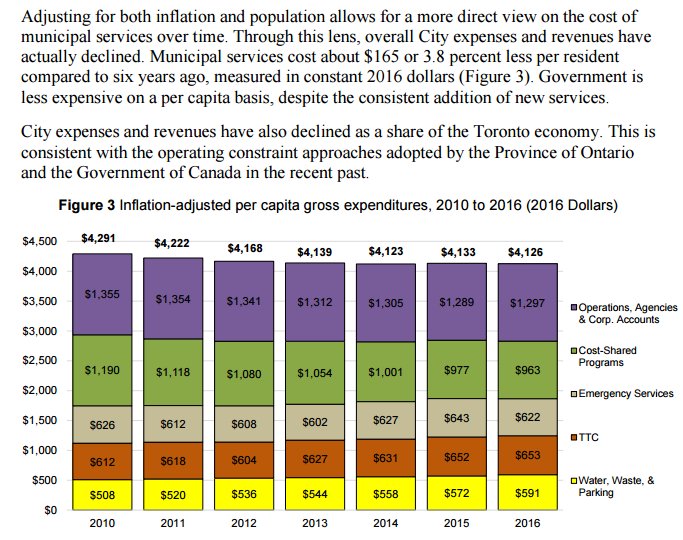For years, the City of Toronto has been deliberately taking in less revenue while expanding infrastructure and services. Forget the “efficiency” bullshit—this has largely been made possible through unsustainable and unreliable funding sources. In this new report, top City bureaucrats warn City Council that they can’t postpone tough decisions any more.
Here’s the full report. It’s like 40 pages. Are you gonna read it? Hell, no! So here’s the gist.
TL;DR:
Since 2010, the City has really cut back on its spending. How has it kept costs low? 1. Other levels of government are picking up some of the tab (“cost-shared social programs”); and 2. Putting stuff off. Especially capital projects, like building transit or repairing social housing.
We’ve also been taking in less money. The City’s main way of raising money is through property taxes, but politicians are committed to keeping property tax revenue increases below inflation. That means that, in real terms, we’re actually taking in less property tax revenue than in 2010.
Instead, we’ve been increasing other revenue, like user fees, water and garbage rates, and TTC fares. Thanks to the booming housing market, we’ve also been making a lot of money from the Municipal Land Transfer Tax. As I explain here, betting on the housing market is a bad idea. And yet the last budget Council passed depended on the assumption that MLTT revenue was always going to be this high.
Peter Wallace: "City Council, we have to talk."
City Council: "new phone who dis" pic.twitter.com/tILuIu088f— Neville Park (@neville_park) May 17, 2016
Year after year, City Council has voted to kick the can down the road rather than grapple with the fundamental problem. Like I said:
[E]very year the City budget starts off with a big shortfall because we always take in less money than we have to spend […] The only ways to get around the structural deficit are a) start taking in more money, permanently; or b) cut back on services, permanently.
(“We told you so,” adds the report.)1
The Numbers
Okay, so if you’ve been paying attention you probably already knew all that. So here’s some hard numbers.

Here’s how much the budget has increased every year. As you can see, Tory’s tenure is pretty much a continuation of the Ford years.
Now, most of this spending growth isn’t adding new stuff. It’s just keeping up with the rate of inflation—we have to spend more money because a dollar doesn’t buy as much as it used to. Inflation is usually around 2% a year.2
There’s a second reason the City’s dollars don’t go as far: population growth. Even if we kept spending exactly the same, we have to provide services and infrastructure for a larger number of people. The report estimates Toronto grows by 1%, or about 30,000 people, every year.
That means that spending the same amount of money (in real terms) per person requires growing the budget by 3% (in, uh, fake terms) every year.

Turns out that once you factor in inflation and population growth, spending is actually going down. The City is spending almost 4% less ($165 per person) than it did six years ago. And at the same time, new programs, services, and infrastructure are being added. Especially infrastructure. We’ve run up a tab of $29 billion in capital projects that we’ve promised but don’t know how to pay for.3
On the revenue side, I previously mentioned that the decrease in property tax revenue has partly been achieved by increases in literally everything else.4
TTC fares (emphasis mine):
Over the past six years, TTC revenues have increased by an average of almost $50 million annually – representing cumulative inflation-adjusted growth of 17.7 percent over 2010 levels or about three percent per year. During this time, more incremental revenue has been collected by the TTC ($303 million) than from Council-set increases to the property tax rate ($237 million).
The Municipal Land Transfer Tax (emphasis mine):
In inflation-adjusted terms, the MLTT has grown by 167 percent from 2010 levels. This is about seven times greater than the growth rate for any other source of City revenue during this time. As a result of this rapid expansion, the City now collects about 1.5 times more revenue through the MLTT than it did six years ago.
The rise in the MLTT has been essential to Council’s ability to maintain at or below inflation-level property tax increases. To a large extent, current finances rely on what has been a windfall revenue gain from a buoyant real estate market.
So one should be cautious of claims that all of this has been achieved by finding “efficiencies” and savings:
"[Reported] 'savings'…do not necessarily represent reductions against prior year's budget or actual expense levels" pic.twitter.com/hhPzP9q68f
— Neville Park (@neville_park) May 17, 2016
The report says (emphasis theirs!),
Recent patterns of savings and efficiencies are nearing practical limits without service changes or other direction from Council.
“Service changes” = service cuts. “Other direction” = revenue tools. But what to cut and what to add are big enough debates on their own, so I’ll end this summary here. For a more detailed read-through, see my Storify.
- Paraphrase. What they actually said: “The annual budget process of the City of Toronto has long included warnings with respect to financial sustainability. City Managers and the Deputy City Manager & Chief Financial Officers have expressed consistent concerns, suggesting a need for stronger expense discipline and additional revenue.” ↩
- That’s right, %! TAKE THAT, TORONTOIST. ↩
- This is a revised number. During the previous budget process it was estimated at $22 billion. “The current approved capital plan significantly underestimates necessary future expense, and provides an inaccurate picture of future sustainability,” says the report. Translation: it sucks balls. ↩
- It gets better. The report notes that, due to the way the budget is presented, money taken from the City’s capital reserves is counted as revenue, which, they say delicately, “potentially suggests that programs are more sustainably funded than is actually the case”. ↩
The only “tough decision” they need to make is to admit that property taxes need to increase faster than inflation. Meanwhile they are cutting commercial/industrial taxes each year to reduce the difference in mill rates, so in effect residential taxes are already increasing faster than inflation but they sidestep that. Rates in the 905 go up higher than in the 416.
This idea of new revenue tools being needed is bizarre – essentially they refuse to raise on tax that is reasonably fair and the administrative cost of collecting more is nil, why wanting to just impose different ways of taxing the same people that would incur new costs and may be even more regressive.